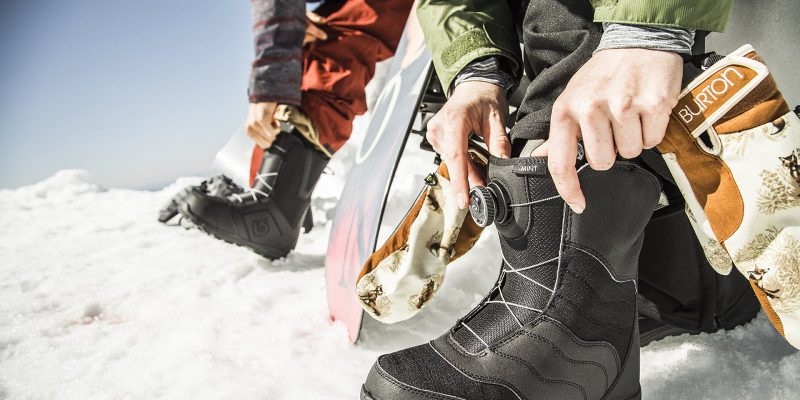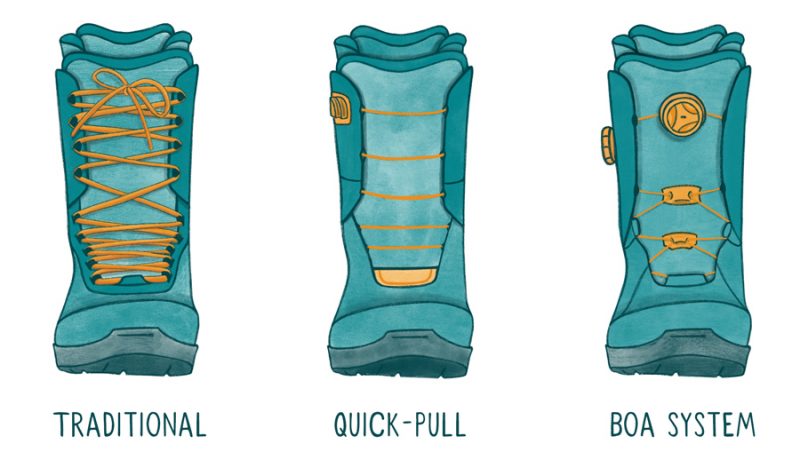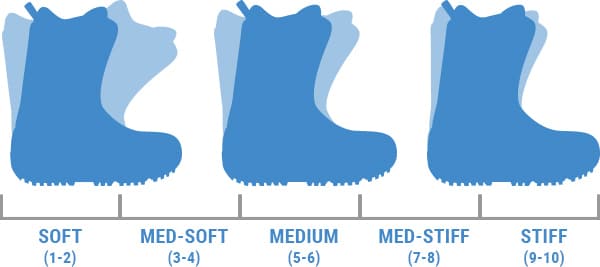3 Top tips to pick your first pair of snowboard boots
We have all thought about getting our first snowboard but have never really put in much thought about snowboard boots. Well, snowboard boots should be your first purchase when considering a full set up and is arguably the most important decision when getting your own gear.
You can have a board with the latest tech and features but if you do not have boots that fit right, you will spend the entire day on the mountain with extreme discomfort, which can be absolutely frustrating.
Which is why, it is important for you to understand the key factors that go into buying your first snowboard boots. We break it down here with 3 things to look out for when choosing your first pair of boots ? fit, lacing system, and flex. Once you understand what these factors mean to your riding, you will be ready to get your very own boots.
Fit

Fit is the most important factor when getting your own boots. You need to understand the type of fit you are looking for when getting boots. It is not as simple as selecting a pair that is your typical shoe size. We recommend trying on the boots in person before buying as boots sizes may vary between brands.
You need to understand the dynamics between your snowboard boots and your board. Snowboard boots need to fit tighter than your normal footwear as it is connected to your board and needs to be responsive when moving your legs. If your boots are not snug, you will feel your heel lifting when turning or changing your edges. This is what we call heel lift, and a big no no when snowboarding. This results in additional movement and strength needed when performing basic maneuvers, which will make you tire quickly.
Snug is the key word here. When trying on your boots, it should feel snug ? especially if you are planning to do a lot of riding, as the padding inside your boots will expand (pack out) up to half a size, creating more space and reducing the responsiveness of your boots.
Let?s now go through the steps when trying on your boots:
- Select a pair of boots in your normal size or up half a size (this is usually the case – you will still get a snug fit)
- Try on your boots with a pair of snowboarding socks (we will get to that later) and do up the entire boot as if you were to go riding
- Toe test: Inside, your big toe should barely brush the end of the snowboard boot (it should not curl up or feel pressure), crouch down slightly to feel your toe pulling back indicating a proper fit
- Heel test: Rock backwards and forwards on your heel as if you were turning a snowboard and if you feel that your heel lifts out of the bottom of the boot about more than 1cm, it may be worth sizing down
- Walk around the room to ensure the boots are comfortable
If everything feels as it should, you?ve cleared the fundamentals on how a snowboard boot should fit.
Lacing System

There are 3 main systems ? traditional lace, quick-pull (speed lace), or the BOA system. Some boots feature a hybrid that blends two systems to utilize the benefits each brings to the table.
It is important to note that each system works great as it caters to different types of riders. The lacing system you decide to go with is ultimately up to personal preference. Here are the 3 main lacing systems on snowboard boots.
Traditional Laces
The purists, rejoice! Traditional laces provide you with the tightest fit because you get to adjust how tight your boots can go without any system restrictions. While speed and BOA laces tend to come loose throughout the day as you move, traditional laces stay snug and tight so you don?t have to tighten them – unless the knot comes loose! They are also easy to replace if you lose them or if they get frayed. However, if you want to get up on the slopes in the quickest time possible, these boots won?t do that for you, especially when tying them up in the cold.
| Pros | Cons |
| Best control over the overall tightness of the boot | Difficult to tie or adjust while wearing gloves |
| Laces are easily replaced if broken | Vulnerable to loosening throughout the day |
| Not expensive | Strength of the rider determines overall tightness
|
Quick-pull / Speed Laces
Speed laces have zonal tightening sections, which means you can fine tune the tightness of your forefoot lacing independently from the ankle and lower leg. This makes it fast, convenient and easy to do so in the cold with your gloves on. This is the most common type of lacing systems in snowboard boots. However, some people have found it difficult to exert enough force to tighten the laces as snugly as they would like to, which results in lesser shin support during toe edged turns. Connection points can also cause pressure points on your shin and ankles, but these usually fade with time.
| Pros | Cons |
| Easily adjusted while wearing gloves | May seem complex at the start |
| Quick and convenient | If broken, not easily replaced on the mountain |
| Customizable fit | Strength of the rider determines overall tightness
|
BOA System
BOA laced boots take speed up a notch with a few turns of the dials to tighten your boots. This makes it easier for people who have difficulty tightening speed or traditional laces. Look out for one or two-dial BOA system boots – a one-dial BOA system boot is applies uniform snugness throughout the foot and ankle, whereas a two-dial BOA system boot allows you to tighten your boot at both the forefoot and ankle area independently. One-dial BOA system boots are slightly cheaper than the two-dials, but BOA boots tend to be the most expensive boots in any snowboard boot range.
The BOA lacing system has grown popularity over the years, largely due to the convenience it brings to riders. This is a great option for those wanting to beat everyone for first chair up the slopes.
| Pros | Cons |
| Fast, easy and convenient to put on and remove | If broken, not easily replaced on the mountain |
| Can be adjusted easily while wearing gloves | Additional cost |
| Precise micro adjustments | Single BOA system only offers one type of fit throughout the foot lacking customizability |
Flex

Snowboard boots are often presented in a spectrum of flexibility, ranging from soft to stiff. Snowboard boots are typically categorized as soft, medium or stiff, on a scale from 1-10 – 1 being the softest and 10 being the stiffest. Each brand will also have their own flex ratings and varying degree of softness – so it?s always best to head to a store to try them on for yourself!
There are 3 main types of categories with flex:
- Soft flex Typically between flex rating of 1-4
Soft-flexing boots are comfortable and easy on your feet for long days on the slopes. This is suitable for first-timers and beginners who need a more forgiving pair of boots when trying out the sport for the first few times.
2.Medium flex: ally between flex ratings 5-7
A great balance between mobility and support for versatile and all-mountain performance.
3.Stiff flex: Typically between flex ratings 8-10
These will give you the maximum support with highest responsiveness at high speeds and tough conditions. These babies will keep you lock and loaded for the biggest of pow days and the sharpest of carves.
Flex may seem unimportant when you are first starting out. However, as you progress, you will have a better understanding of how your board reacts to your boots. Which is why identifying your flex that matches your riding style ranks high when investing in boots. Boot flex is often a personal preference, but flex does align roughly with the type of snowboarding you do.
Okay we are entering territory for more experienced riders as we identify your riding style. However, do not fret if you have not snowboarded before, we will elaborate on riding styles so that it will help make your decision on your flex type.
Similar to flex, there are 3 main categories of riding styles:
- All-mountain: This refers to any terrain suited for a snowboard ? groomers, off-piste, powder and park. Majority of riders will mostly be all-mountain, due to the versatility it allows to riders. All-mountain riding tends to work well with a soft flex For those who prefer a little speed and off-piste areas, a medium flex is preferred.
- Freeride: Backcountry, untracked powder runs are the terrain of choice for those who love free riding. Due to the unpredictability of conditions and obstacles, freeride terrain requires a greater precision and speed, achieved with boots with stiff flex.
- Freestyle: Park riders who enjoy hitting jumps, half-pipes, spins and building their vocabulary of tricks. Fast response, flexibility and freedom are of the utmost importance in the park, so a boot with a soft flex will perform the best in this terrain.
If you are first starting out, a softer flex is recommended to help speed up your progression in the sport but don?t be afraid to go with a medium flex if you foresee the type of riding you will be doing. For beginners, you should always opt for softer boots as they are more forgiving, especially when you are start learning on groomers.
Let?s not forget about your Snowboarding socks
What?s on the inside matters too. Wearing your everyday cotton socks or thin insulation socks on the mountain can lead to improper snowboard boot fit, frozen feet, increased fatigue and general discomfort. ?On the other hand, a common mistake seen with causal riders is the use of thick fluffy, winter socks when snowboarding (this applies to skiing as well). Snowboard socks are designed specifically to work with your foot and ankles’ natural arch & structure. This means your socks have lesser tendency to droop, fall to your ankles or bunch up. These specially designed socks also offer added warmth, moisture wicking properties, and increased comfort, so you don?t have to pile on the socks for warmth! Invest in snowboard socks and your feet will thank you for it.
Go for a fitting session
We?re flexing a little here, but we will be opening Singapore?s first ever snowboard shop and fitting studio in October 2019. This means you get to try on the boots, boards, bindings and accessories on our sunny island before committing to a purchase. We take our snowboarding seriously and we want you to feel the best you can to perform your best on the slopes. Afterall, we?ve only got a limited time on the slopes so makes sense to get the right equipment for maximum enjoyment. Once it?s open, you can schedule a fitting session with us through gear.therideside.com!
